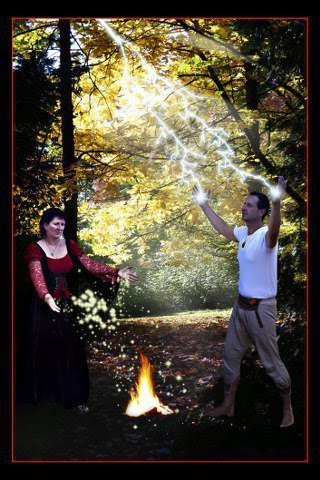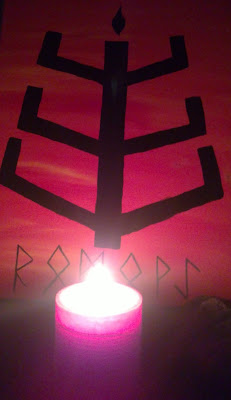Lithuanians traditionally believe that all animate AND inanimate things are living and that all life is sacred. Everything from the plants and animals to the rocks, stars, waters, fire and earth. are all considered to be alive. Earth can be viewed as either a physical, personified and metaphysical element. Lithuanians have always demonstrated all three views in their traditional way of life. In this article I will write about how my ancestral Lithuanians and the local Australia aboriginals related to the Earth and how I then reflect these values in my life as an Australian Romuvis^ today.
Earth, Fire, Air and Water. All are equally important elements to Lithuanians, past and present, but I have to say that deep to the core, the Earth Mother is most dear to them. In Lithuanians, the connection with the Earth and love of nature is inherent and I believe, even stores this trait in the DNA, I liken this attitude towards the earth as the Australian Aboriginal have with the connection to their land. The idea that you could own land was foreign to them because they always understood that the land owns them, feeds them and looks after them!
The passion and drive of Aboriginal peoples to reconnect with their "Land" is a reflection of the same Lithuanian attitude toward the earth or their lands. There are many stories that tell of how when, Aboriginal people return to their traditional lands and visit their sacred water holes, there is a shift in consciousness and a type of centredness is found where many find direction in their own life. It affects them on all levels. Spiritully, mentally, emotionally and physically. I believe this to be the same for Lithuanians. I believe that Lithuanians are never complete unless they have their land. Lithuania has been occupied by numerous countries over the centuries, they have been well experienced in defending your land and your freedom.
Since ancient times, Lithuanian tribes were agriculturists skilled in animal husbandry but fought and died for their land as fierce warriors when forced to defend their beloved land, their earth and their mother, (which happened periodically throughout the centuries.).There were many accounts in the various historical chronicles of the Baltic Crusades where Lithuanians were noted to be very good in battle tactics and were fierce in battle. Lithuanians, (men and women), fought off the Crusaders and invaders for over 300 years and only converted to a pagan blend of Catholicism through marriage with Poland in 1385. This was merely a political marriage designed to finally stop the crusader raids into their lands. The raids did not stop until after the battle of Tannenbug* in 1410 where the Lithuanians organised a collective army from several nations of Pagans, Christians, Catholics and Tatars to finally decimate the German Teutonic Order. This battle ended the Baltic crusades forever.
Even today, Lithuanians have traits of territoriality and a passion for national pride. Lithuanians have even been accused of being neo nazi but there is some misunderstandings. Love of your land and nation does not equate to ideals of white supremacy! It doesn't help the confusion when one of our main traditional symbols is the fly foot cross+ which is displayed in everything from weaving, textiles, wood, brass and steel but then that's another article!
It was not surprising that Lithuanians personified the earth as the Goddess Zemyna. Zemyna is considered to be the most powerful among all Goddesses. Zemyna is the guardian of nature. Anyone who harms nature will be punished and if the humankind becomes too much of burden on nature, then she will simple either cull us in some catastropy or wipe us out all together. It is for this reason that people never joke about her and are quite serious when talking about Zemyna and the Earth that is Zemyna.In Lithuanian mythology, Zemyna is a much loved daughter of the Sun Goddess and the Moon God. In Lithuanian folklore, Zemyna is married to Perkunas the thunderer and gave birth to the many earthly Goddesses and Gods who help her look after nature. People would tenderly kiss the ground in thanks.#
From Zemyna, the earth, we came, in life she feeds and shelters us and in death we shall return to her.
(Our physical body at least).
In summarizing, The earth was and is important to my Lithuanian ancestors and also the Indigenous Aboriginals of Australia, where I live. The Earth is an inteagral part of my life because I want to portray the same values as my ancestors and support the Earth in a way that is respectful and acceptable to the original custodians of this land, the Australian Aboriginals. The Earth and her nature take care of me by feeding me from the crops that produce such abundant harvests and so I happily take care to foster her and support the earth and her nature. I feel that it is my obligation to care for the Earth because she cares for me. I consider myself as an activist and advocate for nature. In saying that, I haven't tied myself to trees or stood in front of bull dozers but I would if called. I do every day things that help to support the Earth Mother and her nature. I plant for the bees, I grow vegetables and fruit to be more harmonious with her seasonal cycles, I compost, I recycle, I attend protest rallies when possible, I support various charities for the welfare of plant, animal and human needs, when I can afford it, to name a few.
A good question to pose myself occasionally is,
"What has the Earth done for me and what have I done for the Earth lately?
After asking myself this, I soon find my moral compass.
References:
^ Romivis is an adherent of Romuva which is the modern revival of the traditional ways of Lithuanian Baltic people and their connection with the earth and the universe.
+ Fly foot cross is also known as swastika. It is important to note that this ancient symbol was displayed to represent luck,happiness, good fortune and was also a symbol for Perkunas, the Thunder God. Unfortunately, since Hittler and his nazi movement appropriated the swastika for their movement of terror, this symbol has been demonised into a fearful symbol. In Lithuanian decoration, there are many different styles of this symbol and most probably is a connection with the Indian(from India) culture and religion.
* The battle of Tannenburg is known by different names. The Poles know it as the battle of Grunwald and the Lithos know it as the battle of Zalgiris. Much can be read about this battle to end all battles with the German Teutons who were constantly raiding Baltic lands and plundering Eastern Europe at large.
# Pope John Paul had a Lithuanian Mother and his ritual of kissing the ground when coming to a new country, was a Lithuanian Pagan custom of reverence for the Earth Mother.











